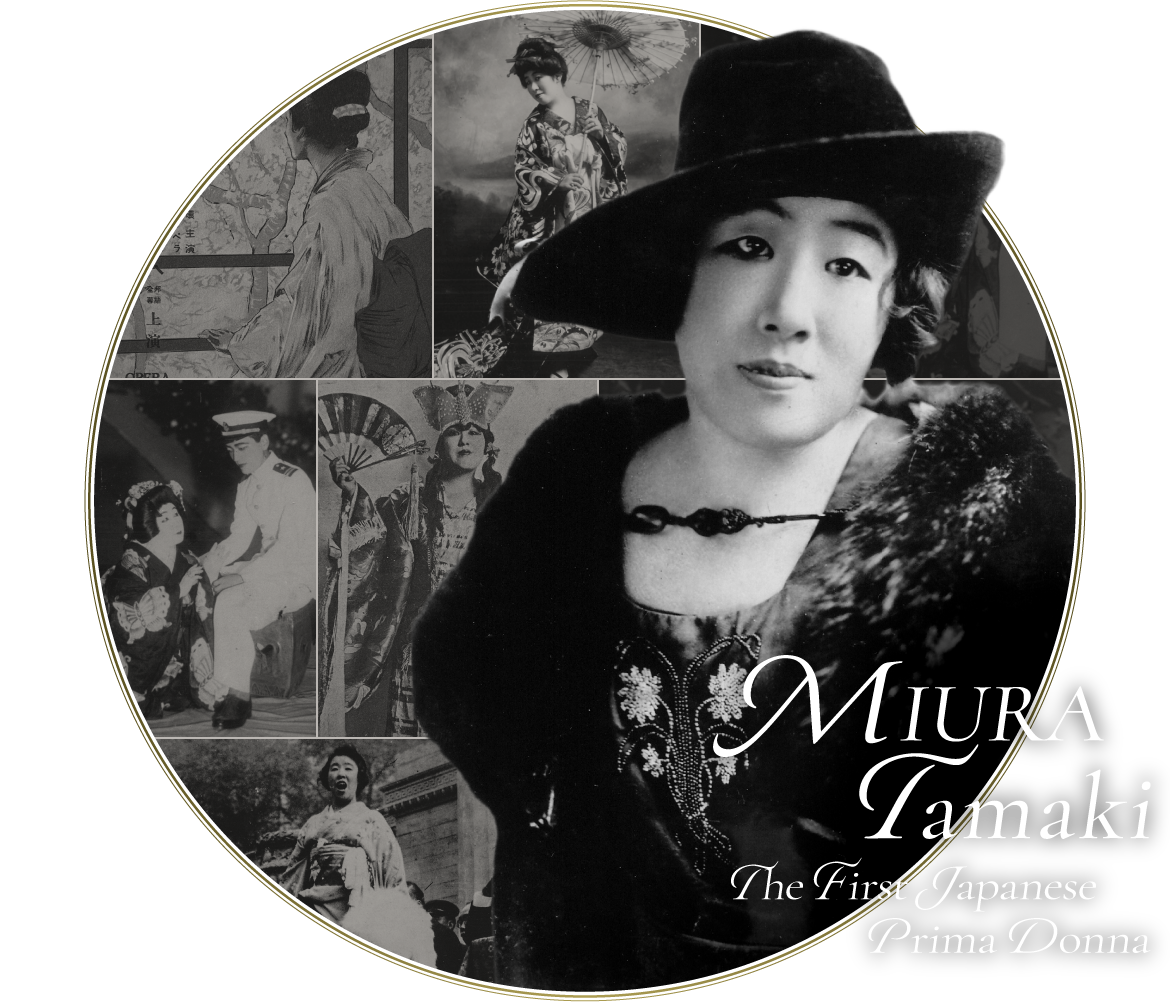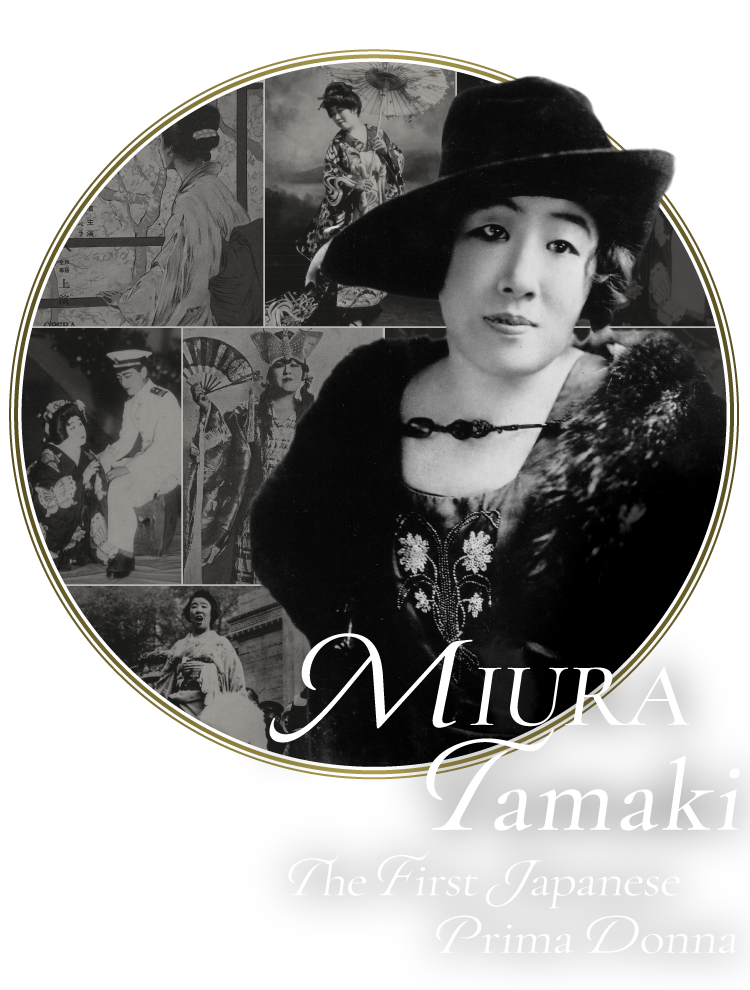Commencing in 1996, the
50th year
after death of
MIURA Tamaki, the Mt.
Fuji
International Opera
Competition
of Shizuoka is
held once every three
years
to commemorate the
world-famous Prima Donna.
ここから本文です。
Early in the 20th century, soprano MIURA Tamaki, Japan’s first and internationally renowned prima donna, attracted attention from people around the world with her exquisite singing voice. To date, her record of more than 2,000 performances as Madama Butterfly has yet to be broken. Only Tamaki among numerous other Butterfly performers was praised by the composer, Puccini. Puccini admired her greatly saying, “It was as if I had composed Madama Butterfly solely for Madama Miura.”
Tamaki was born in Tokyo on February 22, 1884. From an early age, she studied Koto (traditional string instrument), Nagauta (a traditional form of singing accompanied by shamisen), Japanese dance and other traditional arts. These performing arts served as a crucial foundation for her future major role of Madama Butterfly. Aged 16 years, she entered Tokyo Music School, the present Tokyo University of the Arts. Even during her college days, Tamaki was gifted with remarkable talent. In 1903 the 19-year-old girl made her opera debut playing as a major role in Orfeo ed Euridice, Japan’s first opera performance. After the performance, she became a prima donna under contract to the Imperial Theatre. In 1913, she married Masataro Miura, and in 1914, the couple planned to study in Berlin, her husband, medicine and Tamaki, under opera legend Lilli Lehmann. However, when World War I broke out, they swiftly changed their destination to London. In 1915, she played the main role and made a brillianr debut in Madama Butterfly at the London Opera House.
In 1915, the couple moved to New York, after which for 16 years Tamaki performed Madama Butterfly around the world, mainly in the U.S., gaining even greater popularity and worldwide recognition.
In 1935 Tamaki finally accomplished her 2,000th performance of Madama Butterfly, a great achievement, in Palermo, Italy. Tamaki took this occasion to retire from the international stages, and returned to Japan.
After returning, she performed in some operas and recitals in Japan. However, with the onset of war, this was an extremely difficult time for Tamaki as her musical endeavors were not always successful.
Her performance at Hibiya Concert Hall on March 21, 1946 was to be Tamaki’s last, due to her declining health. The audience was incredibly touched by Tamaki singing earnestly with the help of her nurse. At the final curtain call she bowed before the audience with her deepest gratitude, as the curtain fell silently.
She died on May 26, 1946, aged 62 years. Tamaki devoted her life to music, gifted with outstanding talent and good fortune. However, all the people who knew her say, “She was a diligent worker.”
Reference: MIURA Tamaki - Historical Study by TANABE Hisayuki
Tamaki was born in Tokyo on February 22, 1884. From an early age, she studied Koto (traditional string instrument), Nagauta (a traditional form of singing accompanied by shamisen), Japanese dance and other traditional arts. These performing arts served as a crucial foundation for her future major role of Madama Butterfly. Aged 16 years, she entered Tokyo Music School, the present Tokyo University of the Arts. Even during her college days, Tamaki was gifted with remarkable talent. In 1903 the 19-year-old girl made her opera debut playing as a major role in Orfeo ed Euridice, Japan’s first opera performance. After the performance, she became a prima donna under contract to the Imperial Theatre. In 1913, she married Masataro Miura, and in 1914, the couple planned to study in Berlin, her husband, medicine and Tamaki, under opera legend Lilli Lehmann. However, when World War I broke out, they swiftly changed their destination to London. In 1915, she played the main role and made a brillianr debut in Madama Butterfly at the London Opera House.
In 1915, the couple moved to New York, after which for 16 years Tamaki performed Madama Butterfly around the world, mainly in the U.S., gaining even greater popularity and worldwide recognition.
In 1935 Tamaki finally accomplished her 2,000th performance of Madama Butterfly, a great achievement, in Palermo, Italy. Tamaki took this occasion to retire from the international stages, and returned to Japan.
After returning, she performed in some operas and recitals in Japan. However, with the onset of war, this was an extremely difficult time for Tamaki as her musical endeavors were not always successful.
Her performance at Hibiya Concert Hall on March 21, 1946 was to be Tamaki’s last, due to her declining health. The audience was incredibly touched by Tamaki singing earnestly with the help of her nurse. At the final curtain call she bowed before the audience with her deepest gratitude, as the curtain fell silently.
She died on May 26, 1946, aged 62 years. Tamaki devoted her life to music, gifted with outstanding talent and good fortune. However, all the people who knew her say, “She was a diligent worker.”
Reference: MIURA Tamaki - Historical Study by TANABE Hisayuki
Gallery of MIURA Tamaki
MIURA Tamaki herself
 In 1918, MIURA Tamaki sang before President Woodrow Wilson at a victory celebration held at Madison Square Garden
In 1918, MIURA Tamaki sang before President Woodrow Wilson at a victory celebration held at Madison Square Garden In 1932, MIURA Tamaki received an enthusiastic welcome at Tokyo Station when she temporarily returned to Japan
In 1932, MIURA Tamaki received an enthusiastic welcome at Tokyo Station when she temporarily returned to Japan In 1932, with YAMADA Kosaku, former student of hers and one of the great composers and conductors in Japan
In 1932, with YAMADA Kosaku, former student of hers and one of the great composers and conductors in Japan



















